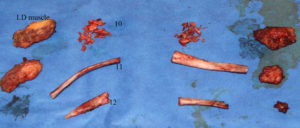Rib removal offers the elimination of the last anatomic obstruction to narrowing one’s waistline. This procedure creates its effectiveness through the removal of the inner bony component of waistline support. The free floating ribs, unlike the ribs above it, have an almost vertical orientation downward with only soft tissue attachments at their small cartilaginous tips. This is why one can push in on their waistline and feel the length of these ribs. Removal of the outer half of the ribs (there is no reason to remove them back to the vertebral facets) allows the soft tissue to move further inward this narrowing the waistline.
But between the skin and the lower free floating ribs lies other tissues which must be traversed. The biggest structure between the skin and these ribs is the latissimus doors (LD) muscle. Known as the ‘lats’, this is the broadest muscle on the back that extends form the upper arm down to the spine and the iliac crest. While the thickness of the muscle does thin at its most inferior extent over the lower ribs, it is still amazing how thick it still is in the lower back region. It is always at least 1cm thick and often as much as 2 cos.

Removal of a wedge of the LD muscle does not cause any functional deficits since the spinal insertion of the main body of the muscle remains intact. This wedge preserves the side to side integrity of the muscle.
Dr. Barry Eppley
Indianapolis, Indiana


